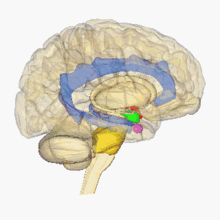| Part of a series on |
| Sex differences in humans |
|---|
 |
| Biology |
| Medicine and health |
| Neuroscience and psychology |
| Sociology |

The neuroscience of sex differences is the study of characteristics that separate brains of different sexes. Psychological sex differences are thought by some to reflect the interaction of genes, hormones, and social learning on brain development throughout the lifespan. A 2021 meta-synthesis led by Lise Eliot found that sex accounted for 1% of the brain's structure or laterality, finding large group-level differences only in total brain volume.[1] A subsequent 2021 led by Camille Michèle Williams contradicted Eliot's conclusions, finding that sex differences in total brain volume are not accounted for merely by sex differences in height and weight, and that once global brain size is taken into account, there remain numerous regional sex differences in both directions.[2] A 2022 follow-up meta-analysis led by Alex DeCasien analyzed the studies from both Eliot and Williams, concluding that "The human brain shows highly reproducible sex differences in regional brain anatomy above and beyond sex differences in overall brain size" and that these differences are of a "small-moderate effect size."[3] A review from 2006 and a meta-analysis from 2014 found that some evidence from brain morphology and function studies indicates that male and female brains cannot always be assumed to be identical from either a structural or functional perspective, and some brain structures are sexually dimorphic.[4][5]
- ^ Eliot L, Ahmed A, Khan H, Patel J (2021-06-01). "Dump the "dimorphism": Comprehensive synthesis of human brain studies reveals few male-female differences beyond size". Neuroscience & Biobehavioral Reviews. 125: 667–697. doi:10.1016/j.neubiorev.2021.02.026. ISSN 0149-7634. PMID 33621637.
- ^ Williams CM, Peyre H, Toro R, Ramus F (November 2021). "Sex differences in the brain are not reduced to differences in body size". Neuroscience & Biobehavioral Reviews. 130: 509–511. doi:10.1016/j.neubiorev.2021.09.015. PMID 34520800.
- ^ DeCasien A (2022). "Sex differences in the human brain: a roadmap for more careful analysis and interpretation of a biological reality". Biology of Sex Differences. 13 (1): 43. doi:10.1186/s13293-022-00448-w. PMC 9327177. PMID 35883159.
- ^ Cahill L (June 2006). "Why sex matters for neuroscience". Nature Reviews. Neuroscience. 7 (6): 477–84. doi:10.1038/nrn1909. PMID 16688123. S2CID 10847255.
- ^ Ruigrok AN, Salimi-Khorshidi G, Lai MC, Baron-Cohen S, Lombardo MV, Tait RJ, Suckling J (February 2014). "A meta-analysis of sex differences in human brain structure". Neuroscience and Biobehavioral Reviews (Meta-analysis). 39 (100): 34–50. doi:10.1016/j.neubiorev.2013.12.004. PMC 3969295. PMID 24374381.